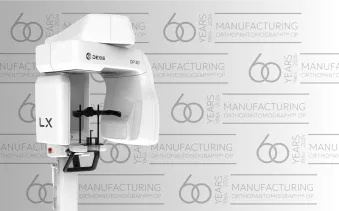
Why Practices Should Consider Adding CBCT Systems
One look at a 3D image captured by a CBCT (cone beam computed tomography) scan, and there’s no question the level and quality of detail far surpasses 2D. Despite the clear advantages, however, some practices still have hesitations about investing in a CBCT system — thinking it’s too complex with more imaging power than is needed. Maybe it’s time to think again.
The good news for dental practices: today’s 3D imaging systems have a smaller footprint, faster scan times, and smarter functionality — making them more accessible, intuitive, and attractive for doctors looking to boost their diagnostic accuracy and expand their treatment options.
Doctors who have already embraced CBCT routinely wonder how they ever got along without it. “Any cone beam, I think, is vital in today’s dentistry,” says Akshav Vij, BDS, ACT, FAGD, and the Director of Esthetic & Digital Dentistry at the Missouri School of Dentistry and Oral Health. “It provides a lower-radiation alternative to medical CT, and it plays a crucial role in our diagnostics, treatment planning, patient education, and student education.”1
So why should more practices — even general practices — seriously consider adding CBCT to their equipment lineup? For starters, CBCT has come a long way over recent years. Unlike traditional CT that requires multiple rotations around the patient, a CBCT scans an entire area in a single rotation — reducing radiation exposure as well as patient chair time.
Along with added speed and efficiencies, CBCT scans can significantly improve diagnostic accuracy and confidence simply by minimizing surprises. Even in the most seemingly straightforward cases, a CBCT scan can reveal hard-to-find issues that might otherwise be missed, reducing the risk of misdiagnosis and the need for retreatment.
CBCT scans are so effective because they show the location and relationship of anatomic structures in extraordinary detail. Using CBCT, a doctor can assess problems like bone loss with periodontal disease in order to determine the appropriate treatment plan. CBCT also enables doctors to offer a wider range of services. With better and more accurate visibility of roots, bone quality, and surrounding teeth from any angle, CBCT improves the predictability of implant and endodontic procedures. CBCT’s large fields of view also support specialized services like airway analysis, TMJ analysis, and sleep dentistry. The detailed, 3D images additionally make it easier for doctors to share and explain treatment planning recommendations with patients for better compliance.
Choosing the right CBCT system takes careful planning and some comparative shopping. It’s important to find a CBCT unit that fits your practice’s goals, space constraints, and staff capabilities. You’ll also want to make sure that the CBCT system you invest in works with your practice’s other imaging systems and software so that you can integrate images and patient data for a complete picture.
To meet the varying needs of practices. DEXIS offers two CBCT systems: the ORTHOPANTOMOGRAPH™ OP 3D™ imaging system and the i-CAT™ FLX V-Series CBCT system. Ideal for practices looking to ease into 3D technology, the OP 3D is an upgradeable system that offers three flexible configurations: panoramic, 3D, and cephalometric. Upgrading the OP 3D from a standard panoramic to a 3D system allows you to vastly expand your range with 36 FOV sizes and four resolutions settings — without expanding your footprint. This flexibility makes the OP 3D a great system for a wide range of services, from single-tooth endodontics and implant surgery to sinus analysis and TMJ diagnostics.
“We use our OP 3D many times every day, not only for CBCT but also for panoramic x-rays and cephs,” explains Kaveh Ghaboussi, DMD, owner of Madison Smile Solutions in Madison, WI. “Any time we are planning an implant surgery or reconstruction, we definitely use CBCT because it makes planning a better, safer, more efficient process.”1
For practices that offer established services such as implants, oral surgery, orthodontics, and TMJ, the i-CAT from DEXIS might be the right CBCT solution for them. i-CAT captures complete 3D images in less than five seconds, delivering a radiation dose comparable to 2D panoramic images, and can capture 2D panoramic images without needing another sensor.
The i-CAT also offers a maximum field of view with the option to scale or collimate the scan height to focus on a particular area of interest. Along with its flexible 3D planning and treatment tools, the i-CAT integrates seamlessly with orthodontic systems, CAD/CAM programs, and imaging software.
Whether you choose the OP 3D, i-CAT, or even both, you’ll want the ability to house, view and leverage all your images — 2D, 3D, clinical photography, and intraoral images — in one centralized location, using one software, for easy access and enhanced efficiencies. DTX Studio™ Clinic from DEXIS does just that.
Ready to integrate with your practice workflow, DTX Studio Clinic provides all the tools you need to capture and present images from all your systems for simplified case presentation and treatment planning. Because DTX Studio Clinic is also compatible with major practice management software, your staff won’t have to waste valuable time and effort reentering patient data. And by centralizing your imaging technology, it allows you and your staff to immediately view images from any room — no more traveling back and forth. Featuring a host of AI-powered functionality, DTX Studio Clinic also reduces time-consuming manual tasks and simplifies treatment planning by automatically sorting, numbering, rotating and placing images in templates.
No longer confined to specialized practices performing complex, advanced procedures, CBCT 3D technology is here to stay and ready for the mainstream. With the right partner, guidance and training, your practice can also capture the advantages of CBCT to improve diagnostic accuracy, expand patient offerings, enhance treatment planning, and drive efficiencies.
1. Dental product shopper. (n.d.). Retrieved March 6, 2023, from https://www.dentalproductshopper.com/article/ebook-picturing-the-future-of-dentistry


